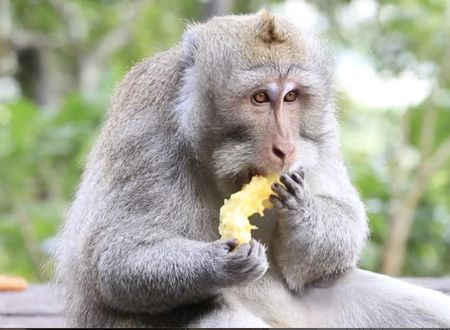True meaning of silence….
We here many quotes regarding the greatness of silence. It is called ‘mauna.’
Most people consider not speaking is silence/ mauna. But it is not true.
In sanskrit to speak/ speaking is called vaak/वाक् /vaani/वाणी.
There are four vaanis according to vedas –
Vaikhari/वैखरी, Madhyama/मध्यमा, Pashyanti/पश्यन्ती, Para/परा.
We will understand these vaanis with a beautiful analogy of Guru and Shishya.
1. Guru is teaching the mahavakya to his Shishya-
” Aham Brahmasmi/ अहं ब्रह्मास्मि।”
Shishya is listening and asking the questions in between. Guru is answering his questions so as to remove his doubts.
This conversation is in the gross speech. It includes sounds and words. It can be heard. This is called vaikhari vaani/वैखरी वाणी. It needs the soundness of the gross vocal organs and subtle power/ faculty of speech. Our daily conversations are carried out in this vaikhari vaani.
Vaikhari vaani is useful in daily transactions. We do prayer, aarati, chanting in this vaani. Students use it for memorising tables, shlokas, poems, etc. It is the vaani through which statements of the scriptures are spoken by the Guru so that Shishya can listen( shravana).
As far as vaikhari vaani is used for some good purpose, it is beneficial. But continuous talking in vaikhari vaani about useless things, gossiping, unnecessary arguments, etc is harmful for one’s spiritual growth. Continuous speaking prevents one to listen, reflect or introspect which is useful for inward journey. It creates noise and nuisance and makes the mind restless.
Remember our childhood, when teacher would ask us to shut our mouths and be silent. This silence; when we stop speaking any words; is the silence at gross level. This is not true silence because during this period we continuously think which is the mental speech or self talk. Silence at gross level doesn’t mean that mind is quiet/ silent.
This silence at the gross level is necessary. It is said that one who speaks less is wise. But totally abstaining from speaking is not always good.
In his Prashnottar Ratnamalika, Adi Shankaracharya states- “Mukah kah/ ? Who is the mute?”
“One who doesn’t speak at the right time.” ( He doesn’t say that mute is one who doesn’t speak at all.)
So although silence at gross level is beneficial, one should speak when it is necessary. e.g. When someone asks for the help, important address or advice. If someone is teaching the wrong; and you think it would hamper the growth of the listeners, you must speak (if you know the right from the authentic source). If someone might get unnecesary punishment; if you don’t speak the truth, you must speak.
So, speak less but the truth which will benefit others to grow spiritually.
2. Now the Guru asks shishya to be silent and reflect upon what he has taught. Shishya doesn’t speak any words but he starts reflecting in the mind about the mahavakya- ” Aham Brahmasmi.”
During reflection/ manana, gross sounds and words are absent but the very words are in the thought forms in the mind of shishya. (‘Aham’, ‘ Brahma’ , ‘ Asmi’.) So externally he is silent but he is speaking in the mind in the thought forms. This very expressions in the thought form is called madhyama vaani/ मध्यमा वाणी.
Every word before we utter verbally; is in the thought form in our mind. We use this madhyama vaani during introspection/manana, study, silent prayer, japa,manas puja, etc. When a person is alone, he talks with himself in this vaani.
Although this self talk is beneficial in certain situations, excess self talk causes mental ailments. Too much thinking makes mind lose its peace. It is the big obstacle in meditation.
One who is not speaking is silent only at gross level but the one who has control over thinking is truly in the silence. To be silent at mind level needs great practice.
3. The shishya who reflects upon the Guru’s teaching- ‘Aham Brahmasmi,’ now start realising the Truth. He continuously contemplate upon that Truth( nididhyasana). Time comes when these two words/thoughts ( Aham & Brahm) are no more separate from each other. They becomes one for the shishya. Anatma vasana ( I am the body) is getting replaced with Atmavasana( I am the Brahma)
But There is still the tendency to give rise thoughts. (potentiallity for differentiation is present.)
Suppose a teacher tells you to remember the name of a street- “Temple street”. You first utter it in gross/ vaikhari,- ‘Temple street’, then you repeat it in your mind/ madhyama,- ‘Temple street,’ but after repeated practice, you neither need to utter nor to think of those two words. The moment that street comes, you spontaneouly become aware of it. Awareness comes in flashes without words or thoughts. This is pashyanti vaani/ पश्यन्ती वाणी.
If someone says ‘ Lord Krishna’, you visualise Him spontaneously. Neither you utter ‘ Lord Krishna ‘ verbally nor mentally, still you become aware of Him. This communication is in pashyanti vaani. Literal meaning of pashyanti is those who see….. The seers ..
The eternal knowledge / vedas are revealed to the Rhishis in this vaani. They have seen the mantras. That’s why they are called ” mantradrasta’. Here seeing is not to be taken literally as seeng with the eyes. It means getting revealed in the heart when they were meditating.
After they have seen / visualised the mantras ( revealation), they wrote it and taught in vaikhari vaani. This is how vedas are called ‘Apaurusheya.’ ( not written originally by any human).
“मैने आम चखकर देखा।”- This doesn’t mean that I have seen the mango taste. It means the taste got revealed to me. That is the meaning of pashyanti. ( To visualise without words and thoughts.)
Many times; we don’t chant verbally and don’t do japa mentally. Still We visualise our deity/ divine without word or thought. This is the pashyanti vaani.
4. Para vani- Guru is the one who is established in his own true nature of Sat Chit Ananda. He is the embodied knowledge/ Consciousness/चित्. He is in no need to utter the knowledge in vaikhari vaani. But for the sake of spiritual evolution of his shishyas, he is speaking. In fact he is the true mauna, whom neither words nor thoughts; are needed. This is Para vaani( beyond or independent of the words,thoughts,desires.)
Vedas ( knowledge/ विद्= to know) are eternal in Para vaani and got manifested/ revealed in the Rhishis / Mantradrashtar in pashyanti vaani.
Thus these four vaanis are useful to the jiva to gain liberation step by step.( vaikhari/ shravana- madhyama/ manana- pashyanti/ nididhyasana- Para/established in tatva.)
Thus the meaning of silence is not just shutting up the mouth. Real silent/ mauna is the one who is established in the true nature of Sat Chit Anandam( which is the complete silence beyond these four vaanis). Such person may seems to act, speak, think but he is said to be real ‘Mauna’.
Once you know the real meaning of silence, you will notice that to be Mauna/ our essential nature is the goal of life for which you have to use these vaanis in proper order.
I have read somewhere the four stages of prayer.
” I talk, you listen.”
” You talk, I listen.”
Neither talks, both listen.
Neither talks, neither listens: Silence. Just Divine Presence.
( At initial stage, God seems to talk and listen to the devotee. But as he evolves, there remains no need to talk or listen. Both become one- the silence.)
So; Speak but the Truth ( body aligned with the divine); Think but the Truth( Mind aligned with the divine), Visualise but the Truth( desire aligned with the divine); You will be the Truth/ the Divine for sure.
Hari Om!









Comments & Discussion
4 COMMENTS
Please login to read members' comments and participate in the discussion.